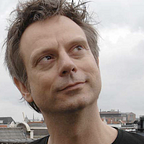The secrets and lies of day 2 of Picnic
Today it was day 2 for me at Picnic and just like day one I wasn’t disappointed. Of course it was not all top quality, but there was enough to trigger my thoughts (despite there were no real new insights). Even apart from all the pleasant meet-ups outside the conference hall of course.
The theme of the day was without a doubt the connection between real and virtual life e.g. the internet of things with the talks of Rafi Haladjian, Michael Tchao and Adam Greenfield.
But also the talk of Genevieve Bell about secrets and lies can be related to this theme.
People like Genevieve are the surprises you are looking for. Her thoughts on secrets and lies related to online social media were interesting. The tension between the possibility to be ultimate transparent in the things we do and the natural need to keep things for ourselves was inspiring.
The concept of privacy and security will be different if you start from the ideas of secrets and lies. Where control by the user is essential. Just like the audience control which is important in the new way we use communities, we also need possibilities to control our transparency.
My emerging thought: designing for online social activity is designing for hacking the truth.
The things Genevieve talked about dealt with the way we adept real life to virtual life. The extreme form of this development to the internet of things was layed out in a very amusing and true presentation by Rafi of Violet, the makers of the Nabaztag Wifi rabbit. I saw this talk before on Reboot, but the months between he surely used to sharpen his presentation, and to complete the new product of course.
The world is divided in connected objects (cobjects) and not connected objects (nobjects), stated Rafi. His aim is to connect all the nobjects in 2010. Therefor he introduces RFID stamps you can stick on all products. Some ambition is never wrong. The Nabaztag rabbit is the hub that recognizes the stamps. I think however it will be very interesting as the recievers of the signals will be based on an open standard and send to the cloud. If all shops have these RFID readers, these can also funtion as recievers of the signals.
As extension of this vision on the internet of things you can connect the talks of Nike and Adam Greenfield. The latter has a strong theoretical but likely scenario where cities become also the receivers and processors of the signals. His concepts of ‘the long now’ and ‘the big here’ are nice definitions of the way all signals create a persistent history of traces of products and on the other hand a deep notion of reality.
Nike shows us the way you can translate all these theory into nowadays successful products and marketing. The Nike+ combines the insights that jogging is a social activity, music is part of jogging and the market is in the motivation-needed jogger.
From the following versions you can expect these will be even smarter in using the traced data into predictions and a virtual personal trainer.
I was expecting that Clay Shirky also touched the point from virtual to physical. This is the theme of his book Here comes Everyone as far as I thought (I still need to read it …). I believe that the principles we learn in online media like customizing of products and conversational choosing are also translated to the ‘old’ physical world. So I think I have to read his book to discover his insights on this topic.
